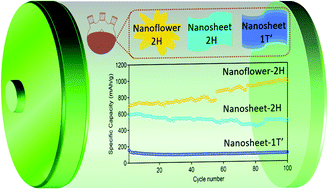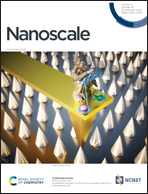Colloidal WSe2 nanocrystals as anodes for lithium-ion batteries†
Abstract
Transition metal dichalcogenides (TMDs) are gaining increasing interest in the field of lithium ion batteries due to their unique structure. However, previous preparation methods have mainly focused on their growth from substrates or by exfoliation of the bulk materials. Considering colloidal synthesis has many advantages including precision control of morphology and crystal phases, there is significant scope for exploring this avenue for active material formation. Therefore, in this work, we explore the applicability of colloidal TMDs using WSe2 nanocrystals for Li ion battery anodes. By employing colloidal hot-injection protocol, we first synthesize 2D nanosheets in 2H and 1T′ crystal phases. After detailed structural and surface characterization, we investigate the performance of these nanosheets as anode materials. We found that 2H nanosheets outperformed 1T′ nanosheets exhibiting a higher specific capacity of 498 mA h g−1 with an overall capacity retention of 83.28%. Furthermore, to explore the role of morphology on battery performance, 3D interconnected nanoflowers in 2H crystal phase were also investigated as an anode material. It is worth noting that a specific capacity of 982 mA h g−1 was exhibited after 100 cycles by these nanoflowers. The anode materials were characterized prior to cycling and after 1, 25, and 100 charge/discharge cycles, by scanning electron microscopy (SEM) and transmission electron microscopy (TEM), to track the effects of cycling on the material.



 Please wait while we load your content...
Please wait while we load your content...